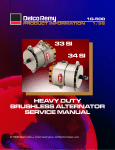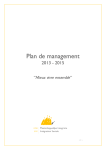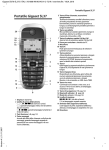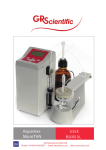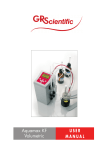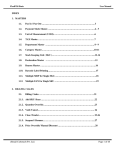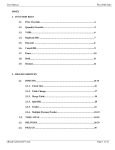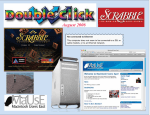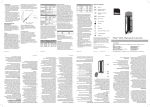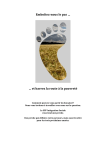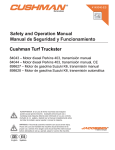Download Cybertech Issue #25 – Since 1990!
Transcript
Cybertech Issue #25 – Since 1990! - Spring/Summer 2008 Page 1 Cybertech Issue #25 – Since 1990! - Spring/Summer 2008 Cybertech Issue #25 – Spring/Summer 2008 Website – http://www.digivill.net/~ticom/ BBS - ssh:osuny.co.uk, Username: BBS, hit return for password Editor/Publisher – Thomas Nathaniel “Ticom” Gray <[email protected]> Proofreading by – Vivian Articles by - Ticom, Vivian, & Wildflower Shoutouts – OSUNY, fellow LJ denizens, Snarling Chesty, Rightcoast, Brian Oblivion, Dr. Who, G-Net, Oberon's Children, Mark O' Ryan, the usual anonymous crowd, and all like-minded individuals and fellow travelers who've gone through the looking glass to join us in Galt's Gulch. Table of Contents: Page 3 4 7 13 24 33 Title Editorial Local Spectrum Surveys Using Your Police Scanner by Ticom Wildflower's Notes, March, 2008 by Wildflower Wildflower's Notes, April 2008 by Wildflower The Lessons of John Titor, Part 1 by Ticom & Vivian Easy Ring Detector by Ticom Cybertech is published by Thomas Nathaniel “Ticom” Gray and The Children of Oberon Society for Like-Minded Individuals and Fellow Travelers Protective Guild, New England Chapter. It is available for free download from http://www.osuny.co.uk/~ticom/. Cybertech is solely intended for like-minded individuals and fellow travelers to learn the necessary skills and mindset in order to survive and prosper during the coming End Times. You all know who you are. It is not intended for individuals who commit mal per se crimes, or who wish to victimize and dominate others. Using the material for those purposes is prohibited and you truly do not want to meet our Omega Squad. Non-commercial distribution of this publication is encouraged, provided it is distributed in its unaltered entirety. Who is John Galt? Page 2 Cybertech Issue #25 – Since 1990! - Spring/Summer 2008 This past April marked the eighteenth anniversary of Cybertech's birth. The 'zine is now old enough to vote and get drafted, but not yet old enough to walk in a bar and have a beer; back when Cybertech was first published, eighteen to twenty-one year-olds who were on active duty could walk into an enlisted club on post and have a beer if they so desired. At the time, I was on active duty at a backwater post in America's middle west, and I enjoyed many good times over some drinks with my fellow soldiers who off-post would be considered under age. We only had one guy who got a little out of control with his drinking. One night we had a little attitude adjustment session with our barracks-mate, and he decided afterwards that getting drunk, rowdy, and stupid was not a good idea. We didn't need any legislators or psychotic teetotaling activists to help us take care of our problem, and Private Redacted still probably thanks us to this day for helping him out before his drinking became a real problem. Denying the right of kicking back with a couple of drinks to an individual who is old enough to get drafted and killed in a war is one of the more shameful things this country has done, but I digress... Cybertech was a war baby. I graduated basic training just before Christmas of 1989, and Cybertech's first issue was released in April of 1990 just before By an Order of the Magnitude was published. Going through military basic training is a life changing experience. The effect is more noticeable with some people than with others. I was working on the book for about two years prior to joining the military, and what I saw and learned in those two months was enough for me to not only finish the book in very short order, but also decide that a periodical espousing the same philosophy and technical method for preparedness was necessary. While the “end of the world” has not occurred over the past eighteen years, I see that the need for a periodical like Cybertech is even greater now than it was back in 1990. In those days, I, like other survivalist writers, (some with much more experience than me) expected to see a collapse in this country within six years. While a complete collapse did not occur, we did see the country sink to new lows during the Clinton administration, and the downward trend continues to accelerate. What are we like-minded individuals to do? The answer is one word: Nothing. Do nothing that will help extend the life of the falling empire. Deny the fruits of your mind and your labor to those who seek to destroy you. Become like John Galt, the protagonist of Ayn Rand's excellent novel (and required reading for all LMIs) Atlas Shrugged. Find a nice place in the country or a small town where you can weather out the slow decline of the country. Acquire the means to protect yourself, alternative means to get around when our crumbling transportation infrastructure finally fails, and gather around a group or at least five of your friends that you can trust your life with. Don't get involved in any activist ventures. Those who eventually become fellow travelers must first see things for themselves. Invest in yourself and in your like-minded friends. Acquire the skills and tools that will be needed for the rebuilding that will come after the collapse. Work to become as independent from “the system” as possible. Do not seek employment from large corporations or the government. Work for yourself if possible, and support the underground economy. The recent selection of presidential candidates clearly shows us what the American masses want, or what they were told they want. Either way, they are getting what they deserve. However LMIs know better, and have nothing to worry about. With our varied self-reliance and preparedness-oriented skill sets, we can ride out the downward spiral and rebuild after it hits bottom. Then we can share a few ideas as to how to make things better. -Ticom Page 3 Cybertech Issue #25 – Since 1990! - Spring/Summer 2008 Local Spectrum Surveys Using Your Police Scanner Scanner hobbyists have it easy these days. After buying a scanner at their local communications dealer or Radio Shack, they surf on over to radioreference.com and click on their home state and county. That's fine for finding the common frequencies, but it won't tell you all the odd places in the spectrum where the locals hang out, or just how far away you can listen. To find out these essential elements of monitoring information you need to do a good local spectrum survey. A spectrum survey is where you use the search function of your scanner across its entire frequency coverage range over a period of time to find out exactly who is operating on what frequency in your local area. In order to get the information you can't find on the Internet, you need to do a spectrum survey. A good spectrum survey takes some time, but when you are finished you will have an insight on the radio communications scene that no website will ever provide you. Spectrum surveys are easy to do. The tools you need for a local spectrum survey are already at your disposal. You need a police scanner with a search function. Just about every scanner sold these days has a search function, from the $100 Bearcat you bought at Wal-Mart to the $500 digital trunk-trackers. Higher-end units will have greater frequency coverage. You would ideally want to cover the whole spectrum from 251300+ MHz., but the VHF, UHF, and 800 MHz. land mobile bands is 90% of what you'll want to survey. P25 reception is anything from handy to essential depending on how many P25 LMR systems are in you area. PL/DPL tone decode is also handy for identifying different users on the same frequency. You don't need it, but it makes the task of identifying a specific user much easier. Trunk-tracking is one of those things you will absolutely need if you have a local trunked system you wish to survey. Here in New England trunk-tracking and P25 is a necessity, and if you're serious about doing a spectrum survey in this neck of the woods you really need to bite the bullet and buy a digital trunktracker. You can get a basic survey down without one, but you'll be missing a lot of monitoring opportunities. Page 4 Cybertech Issue #25 – Since 1990! - Spring/Summer 2008 You will want the best antenna you can afford to get. However the best antenna doesn't necessarily mean the most expensive. Handheld scanners should at least have a telescoping whip antenna. An external multi-band antenna on the roof of your residence would be preferable if you can swing it, especially when compared to the built-in antenna that most base scanners use. The better the antenna, the further you'll be able to receive. The best single antenna solution for doing a spectrum survey would be the common discone antenna sold by Radio Shack and other communications dealers as a scanner antenna. More advanced hobbyists use multiple high-gain monoband antennas for each frequency band of interest. Most often they use commercial LMR antennas or ham antennas for ham bands that are adjacent to the band of interest. Ham antennas on the 2 meter and 70 centimeter ham bands offer good reception characteristics for the VHF-High and UHF land mobile bands. VHF-low band monitors will often employ 6 meter or 10 meter ham antennas depending on what end of the low-band they want to monitor. Building custom antennas for specific bands of interest is also easily and inexpensively done. Those interested in rolling their own are advised to check out the ARRL Antenna Book. You will need a means of recording frequency and other communications data. Some people use a PC with database software, while others such as myself prefer a simple notebook. A friend and fellow monitoring hobbyist, the late Roger Cravens (KE4YQZ/SK) was fond of using a form he developed on a word processor that had rows for each field of data he was interested in. This form will be familiar to those who remember his writing on SESIG, Fidnoet, Scan-L, Fedcom, Usenet, and in US Scanner News. For those who missed out on what many consider to be the golden years of VHF/UHF communications monitoring, it looked like this: Freq. PL/DPL Signal Quality User Location Comments This form could either be printed out and used manually, or used directly on the word processor where the data could be sorted by a particular column. Use whatever you are comfortable with. The final tool you need is knowledge. Take the user manual that came with your scanner and read it. Then read it again. Most issues I have seen people encounter with their scanner can be resolved by the RTFM technique. You will also need knowledge of spectrum allocations and local frequency assignments. What frequency ranges are used by public safety, businesses, ham radio, or personal communications? VHF highband is 148-174 MHz., but what parts of that spectrum are business, public safety, or federal government allocations? What frequencies are licensed for what users. If the local police department is on 155.310 MHz, then it is likely that their unlisted unofficial channels they use when they want a little extra privacy will be in the VHF high-band too, especially if all the other departments nearby are on VHF high-band. While eventually it will be your aim to survey as much of the RF spectrum as you can, you will want to initially concentrate on certain areas that hold more promise than others. The best source of information on frequency allocations was the Consolidated Frequency List that appeared in the back pages of the defunct Police Call frequency guide. If you can find an old copy of Police Call at a flea market or hamfest, it would be worth purchasing it in order to have a copy of that list. With Police Call out of production for a few years now, it may also be available on the Internet. I suggest trying a Google search. A road map of your state and neighboring states is an optional item that comes in handy. It will assist you with your geographical knowledge, especially when monitoring on the fringes of your listening range. Get some push-pins and put your map on a cork-board. When you log a particular location, mark it with a push pin on the map. Over a period of time you will get an excellent idea of Page 5 Cybertech Issue #25 – Since 1990! - Spring/Summer 2008 what areas you are able to listen to. You could also use different colored push-pins for different frequency bands or antennas. Upon reading the specifications of your scanner in the user manual, you will discover the scanner's search speed, usually given in steps per second. This is one of the more important specs you will need to know, as it tells you how much spectrum you can efficiently search at a given time. The average transmission on a “tactical” channel is three to five seconds. Most public safety and business radio transmissions are usually longer than that, but five seconds is a good guideline. At 50 steps per second, you will cover 50*5 or 250 steps. On VHF high-band with a 5 KHz. channel step, that equates to 250*5=1250 KHz. or 1.25 MHz. On UHF with a 12.5 KHz. channel step that figure is 3.125 MHz. If you search a bigger piece of spectrum than that, you run a risk of missing the more interesting tactical channels. This information only applies to conventional scanners. Those scanners with near-field reception capability such as Close-Call and Signal-Stalker have much faster search speeds for finding frequencies, but at a cost of significantly reduced reception range, about a thousand feet versus 20 or more miles for a high-powered repeater on a mountain or a couple miles for a handheld. How long you search a particular piece of spectrum depends on how much detail you want in your survey and the amount of activity the spectrum sees. When dealing with your standard VHF/UHF land mobile stuff, running a search for a couple days will probably net you around 80% of the activity that is there. The longer you search a portion of spectrum, the more you will find, although eventually you will reach the point of diminishing returns. This will probably range from a couple weeks on public safety and business LMR allocations to months for some federal government and military communications. The quickest users to map are police departments, public works departments, transportation (taxis, buses, trains, aircraft et. al.) and businesses. They are constant users of their frequencies. Fire departments and ambulance squads are second, as they only use their radios when they have a call. Emergency management and disaster response frequencies are only used when needed, or when testing the system. They could take the longest, and you may want to survey certain parts of the spectrum during special events or during an actual disaster response in order to find them. The final aspect of spectrum surveys I'm going to mention is the sharing of information you've discovered during your survey, particularly stuff that isn't already available on the Internet. I would share it with good friends who are also into communications monitoring and who share the information they find with you. I would not share it with anyone else. While all licensed land mobile license data is available via the FCC ULS website, it takes some effort to research the information and it would appear that the majority of “scanner hobbyists” lack the ability to do their own research. There are also sites such as radioreference.com and scanner e-mail lists, but they are mostly populated by second-handers who simply feed off the 10% of the membership who contribute information, and by the actual LMR licensees and service maintainers who use them as a excuse to sell and implement encryption and communications systems that can't be scanned. Why cause yourself and other serious monitoring hobbyists grief by contributing to that debacle and getting nothing of value in return? Running a spectrum survey goes beyond the standard scanner dweeb/whacker fare of plugging in a few local public safety and business frequencies, talking about last night's traffic accident on the Yahoo group, and complaining when your local PD decides to go encrypted. You will gain a pretty good insight on your locale's electronic order of battle, and a healthy respect for what it takes to do serious communications monitoring. If your local public safety agencies decide to encrypt, you'll have enough information to still be able to get the big picture by switching your monitoring efforts to more “mundane” unencrypted systems that provide the same information. Stay discreet, good luck, and good monitoring! Page 6 Cybertech Issue #25 – Since 1990! - Spring/Summer 2008 WILDFLOWER’S NOTES – MARCH 2008 FOREWORD “So it’s the end of the world” Whoopee do, it has always been there looming in our futures, plague, famine, war, the collapse, whatever. So far so good, there has not been a real world killer yet leaving the survivors in a post stone age aftermath yet scrambling in daily survival cooking the old family pet over a crude barbecue setup. (Or a fat neighbor). Ho, ho, ho. So what are you going to do when the shit hit’s the fan for real. Most likely be a panic because no matter how hard life was before, that be damn easier to live with than in the aftermath. Unfortunately, it be what you know and got on hand to deal with whatever is now for real. Those whom were prudent enough to stock something aside like food, camp-gear, survival books and tools, extra medicals, and more; you got something to fall back onto to decently survive by. Those whom never did anything, screw you is my blessing, you poor wailing idiot. But then if you are foolish trying to steal mine, you be dead sooner. In the post aftermath world, the credit card and currency issued be of little or no value; ditto be said for coins like those of gold or silver be of any value except “metal content”. Your most likely exchanges be in useful items like 22 ammo, whole spices, can foods, batteries, condoms, and anything else once purchased freely from now looted stores. You also could exchange skill values like welding, dentistry, labor, or even sex for some sort of goods that could be used for self or future barter trades. As time goes by, those whom were able to create a library of useful books, basic hand tools, and certain other supplies; be trading homemade parts, soap, fuels, and medicals in their local markets. When for example, local supply of ammo is no longer available, locally made flintlock rifles and gunpowder will command good exchange values. Or ground glass lenses for those with failing eyesight. Those whom grow stuff, such items besides food be welcome; spices, tobacco, wild-wood weed, medical herbs, and bamboo can also be bartered too. Those whom made it that far will chuckle about the campfires stories of those silly idiots of the past. So while we are living in $4 a gallon gasoline, high prices for everything else, and no pay raises world. Those whom won’t prepare, enjoy it now, and please afterwards don’t wail too much, just shut up and die please.. Us real prepared survivors have better things to do. A HOMEBUILT VACUUM CHAMBER Those whom “vacuum seal one jar at a time”, a tedious job it is. If one could “vacuum seal” several or more jars at a time, self productivity be easier over a shorter period of time. Some years back built a vacuum chamber big enough to actually seal eight at a time , quart mason jars filled Page 7 Cybertech Issue #25 – Since 1990! - Spring/Summer 2008 with dry beans or wheat for myself and friends. Using a vacuum hose attached to the truck’s vacuum lines , was able to vacuum seal at 15 to 20 inches on an idling engine. For you novices, one inch on your vacuum gauge equals 1000 feet above sea level so 15 to 20 inches is 15000 to 20000 feet above sea level. NOTE# Or roughly “3 miles up”! Acquired a “30 gallon” steel shipping drum from a surplus dealer along with its intact rubber “o ring seal”. Washed it out with soap and water, then set aside to dry. As in ( A ), drilled two holes, one was ¼”, the other was ½”. As in ( C ) Then with two-part “welder’s epoxy” attached a 1/4” pipe to the ¼” hole. This serves as the outlet to attach the vacuum hose. To the other hole with the same epoxy, attached a salvaged “water cooler” valve, which serves as a “vacuum relief inlet”. As in ( B ); if no valve is available, one could attach a homemade “FLAP VALVE” cut out of salvaged auto tire inner tube with its flap hinge end “GOOP ’d” to the lid top. Page 8 Cybertech Issue #25 – Since 1990! - Spring/Summer 2008 In any case, grease the “O” ring with light oil or petroleum jelly. NOTE# no “O” ring? Could try using “rubber seal tape” (or slit a length bicycle tube) for a few wraps around the outside of the drum rim, allowing some material over the rim to the inside of said drum. This sealing material is important when the lid is fitted/ fastened to drum top to prevent air leaking into the vacuum drum. The next picture shows two layers of mason canning jars separated by a piece of wire grid screen. Each jar filled with desired contents, is toped with a rubber seal canning lid with the screw seal band loose. When the air is allowed back via the valve, only then screw tight those lid retainer bands to help keep the lid tight protecting the vacuum and contents intact. Remove jars wearing gloves carefully, then stack away on storage shelf. Take care handling as any crack in the glass could become an implosion of contents and sharp glass shards. Page 9 Cybertech Issue #25 – Since 1990! - Spring/Summer 2008 The next picture is a basic hookup between the drum outlet to the engine vacuum line. This hose can be purchased at most auto supply stores, along with a three way connector and a mechanical engine vacuum gauge. Cut hoses to lengths needed, and grease with petroleum jelly the connectors to fit into the hose. My setup also included a small inline gas filter (not shown) to protect the engine in case any dust entered the vacuum line. No hose clamps were needed but one can included them if desired. Page 10 Cybertech Issue #25 – Since 1990! - Spring/Summer 2008 The basic operation, fill jars to 90% with contents, top jar with canning lid, then retaining band left loosely tightened. Place each one into chamber carefully, if in layers separate with heavy wire screen. Place lid on top. Your auto engine should be already running at idle. Hook up between drum outlet to vacuum inlet of auto engine ( the brake vacuum line I’ve used) with inline connector of choice.. Just hold down drum lid, if the drum seals are good, will achieve 15 to 20 inches noted on your vacuum gauge. Then open your air inlet valve on the lid. As air equalizes the jar lids seal vacuumed jars of desired product. Remove drum lid, and with gloves remove each jar carefully, check lid with eyes if sealed, then tighten the band to keep the jar properly sealed. Move each jar to storage shelf as knocking the glass can crack jar with implosive force! Repeat this process till all jars are done, then unhook the setup and put away for another day. This basic setup allowed me to vacuum seal up to twelve quart mason jars of wheat, pasta, dried beans and peas, and lentils. Vacuumed jars containing oatmeal, tobacco, or soft candy tended to loose vacuum seal to outgassing of contents with a few days. Do not try vacuum sealing ammo, gunpowder, butane lighters, or water; it may prove a quick deadly disaster. Same noted with batteries, capacitors, and oiled goods. Page 11 Cybertech Issue #25 – Since 1990! - Spring/Summer 2008 As for vacuum chamber, one could substitute a large metal ammo can with good rubber seal. Do not use plastic drums, pails, or even metal trash cans as most trials resulted in implosions of all three. Those savvy enough to acquire a used refrigerator compressor should before using, should pump a cup or two of 10 weight motor oil to lubricate the pump. Also should enclose the compressor with a good fan as these motors will run hot in a short time. In. normal use in closed loop refrigeration there is along with its gas charge a light oil lubricant. So therefore to prevent seizure, which will render pump useless, pre-lubrication is necessary every time. Also when in operation be allowed to cool between jobs power off with the fan still on. This was learned the hard way by myself. Ten years ago vacuum sealed jars of wheat, lentils, peas and beans. In a recent check, out of two hundred sealed jars, only 4 had bad seals. A friend whom purchased a vacuum bagger kit, found most of the bags leaked within a few months time. Also noted the vacuum pumps on many of these sealer machines developed faults or quit working after 40 seal jobs on average. LAST WORD The price per gallon of regular gasoline may reach $4 by this summer, at last fill-up was just $3.41 per gallon. As rising fuel prices increase so will anything produced, packaged, shipped or sold rise in prices too, the only thing staying same will be one’s paycheck. Most are coping with wiser use of fuel, buying in bulk items needed, using a bike or moped for short trips, and combining errands into one trip. There are many not buying expensive items, or planning long trips, as money has to saved and spent on essentials. What is worse as consumer demand or purchasing, a ripple effect in those employed is occurring as layoffs resulting in more unpaid bills and debt. This will close more stores, factories, warehouses; all increasing the number of unemployed. No doubt shall see more people unable to afford decent food, get sick, and go slowly mad resulting in deaths. A grim future yes for those whom never learned how to take care of themselves or even bothered to prepare a survival cache of emergency food and other items. There be a lot of needless suffering, sickness, homeless, and eventual violence while the people whom profit from rising fuel costs can afford to live in well protected gated communities elsewhere. No matter who wins the election, there be no “magic bullet” to stop this decline. Even those whom purchased gold and silver might find any surviving currency to exchange in, see their metals seized while be sent to a forced labor camp. It may be my final sarcastic note that “the party is over folks” and “the grim-reaper is knocking at your door to collect on what you owe”. Welcome to your new hell, people! May I be wrong about all this too. Page 12 Cybertech Issue #25 – Since 1990! - Spring/Summer 2008 WILDFLOWER’S NOTES - APRIL 2008 ODDS AND ENDS MAKE A FOOT POWER WHEELIE Some years back, out of recycled materials and hardware built a “WHEELIE” to utilize foot power to mechanically rotate a homebuilt alternator for a survival demo. The “WHEELIE” took only several days to build from scratch. Page 13 Cybertech Issue #25 – Since 1990! - Spring/Summer 2008 The homemade alternator, built with salvaged microwave magnets and cooling fan coils used LED’s to rectify the current, produced about 12 VDC at 1 AMP. This was constructed from a drawing within six days. The objective at the time was to demonstrate that “homemade power” could in a post aftermath could be built from salvaged materials available in many areas. The alternator was just a perfect demo to show the main feature, a foot power “WEELIE” that could supply mechanical power for pumps, food grinders, cable linked rotary tool-bits. This is simply notes and descriptions that can help you brew up your own freeware version of my “wheelie” . Made from pallet wood “2 x 4’s”, this could have been built even from lumberyard prime wood, metal, or plastic wood. But hey pallets were free to find and salvage. Page 14 Cybertech Issue #25 – Since 1990! - Spring/Summer 2008 The average length of pallet “2 x 4’s” average about 44 inches each, took three pallets to yield 12 of these boards needed. 8 of these were “center drilled” at each end with a 3/8” wood bit and drill press. 2 of these 8 were measured and drilled in the middle centers with same bit. (These two wood sections for the bicycle wheel axel to be fitted into.) Two of the “2 x 4’s” were used as the bottom boards attached to the above frame with sections of slotted angle and 3/8” bolts and nuts. Finally the last two boards, one became the pedal “push board”, the other was measured, drilled and cut into “2 x 4 x 4’s” wood washers. These are used in the middle of each corner of the top frame. All the frame 3/8” bolts, nuts and washers used in this project were salvaged from a local contraction bin. Funny how much unused hardware gets dumped after a Page 15 Cybertech Issue #25 – Since 1990! - Spring/Summer 2008 job by the contractors. The push ( pedal) board is attached to one of the bottom boards with a salvaged hinge from a garage door. The other end (not shown) has a side 3/8” screw ring to attach the chain cord to. From a curbside source, acquired a 26” “mountain type” bicycle which was in good condition, yet thrown out for what reason? First off, salvaged the rear wheel and chain, then the front wheel and various cables for the junk-box. (The frame was later cut up for the metal recycler bin downtown.) this rear bicycle wheel was important because it didn’t have an internal drum brake. So I assembled the frame, starting at the bottom, then the sides, and finally the top, taking care to assemble will holding the wheel hub bolt into the two middle top holes. Because the wheel was wide, had to use wood washers to space the bottom and top boards apart. ( It is important that the tooth gear on the bicycle hub is on the same side as the pedal push board.) The bicycle chain was cut into one long length. This was positioned over the bike hub gear, one end tied to a rear elastic cord that was tied to a bottom screw ring. The other end tied to a cord that was tied to the push board top ring. Now as you push down on the board the chain pulls the gear of the hub forward. The board is allowed to come back up, because the rear elastic cord pulls the chain and board back. Because the hub drum has no brake, the bicycle wheel can continue rotating forward, as you move your leg up and down pumping the pedal board. This here is the “WHEELIE”, a foot powered source of mechanical energy which with a belt in the wheel rim to a pulley driven generator, pump, or any other need. The homemade alternator, had used a rope as the belt, tension adjusted by hand, then by moving the alternator back a bit and re-clamping it to the top frame. Crude, yes; but it worked well that day. The elastic cord, could have used a section of inner tube as a substitute. But hey, this whole thing was designed and put together within a week. Could had used other materials, hardware, hinge, whatever. Feel free to experiment with your own version. All my projects are “FREEWARE” or “open source”, free to be duplicated by anybody, anywhere or anytime. If you decide to build it for a trade item, do take care to “idiot proof” as best you can. Page 16 Cybertech Issue #25 – Since 1990! - Spring/Summer 2008 Now as for the homemade alternator, it too was built with salvaged wood, parts, hardware, and even the magnets and coils. Basically used a bicycle hub, mounted in a “2 x 4”, one end to a homemade wood pulley sheave, the other side held the rotating disk with alternate “NSNS” magnets. How to mount a bicycle hub in wood? See the next illustration(s) please. (A) COMPLETE HUB FROM A FRONT BICYCLE WHEEL (B) DIASSEMBELED, THE HUB CENTER IS CUT OUT AND REMOVED FROM THE HUB. (NOTE# A Dremel re-in forced metal cutting disk was used instead of a hacksaw) Page 17 Cybertech Issue #25 – Since 1990! - Spring/Summer 2008 ( C ) IN A “2 x 4” FIRST DRILL A HOLE THE DIAMETER OF HUB CENTER, THEN WITH A ROUTER CUT OUT AROUND THE HOLE TO ACCOMADATE THE HUB FLANGE BEARING CUP. FROM THE TOP OF THE WOOD, DRILL A 1/8” DIAMETER HOLE FROM TOP ENTER DOWN INTO THE CENTER HOLE. ONE COULD THEN (OPTIONAL ) SAND AND SPAR VARISH HOLES. (D) SHOWS A REASSEMBELED BICYCLE HUB EMPLACED INTO THE WOOD HOLE. BEFORE ASSEMBLY, GOOD TO SOAK BEARINGS IN OIL, AND THE INSIDE HOLE WITH SOME WHEEL GREASE OR PETROLEUM JELLY BEFORE ASSEMBLY. LATER ON, AFTER A FEW HOURS USE, OIL THE ASSEMBLY VIA THE TOP OIL HOLE. GOOD TO REPEAT EVERY WEEK OF USE. (NOTE# used filtered motor oil can be used) Page 18 Cybertech Issue #25 – Since 1990! - Spring/Summer 2008 SALVAGING PALLET WOOD In most cases, people collect wood pallets just to cut up and burn for heat. However, there are others whom will use wood pallets as a source of “free wood” for constructing furniture, workbenches, wood items, and even sheds and houses. All pallet wood is generally rough cut and powered nailed together. Sources of wood may include pine, spruce, ash, oak, chestnut or even exotic woods including teak and redwood. The “2 x 4 ‘s” and “4 x 4’s” are cut to true sizes versus the finished versions sold at a lumber outlet. To take apart a pallet, good to wear gloves as splinters will always be present. Most times a pallet may be knocked apart with a 2 or 5 pound sledge, the nails be “tapped out” and then pulled with a nail remover crowbar. Salvaged nails can be straighten and reused. After separation, the wood pieces should be set aside in a stack (with the layers separated by short wood sections) inside the building to dry out at least for a month before using. To salvage plywood off a pallet, grind off the top nail heads, then with hammer taps and prying with a crowbar, separate the plywood from the runners. This way, you avoid damaging the salvaged plywood. As for removing the headless nails from the runners, a 10WR VISE-GRIP Pliers works best in gripping and removal. In using the pallet wood, one should pre-drill before using nails or screws. For workbenches to sheds, am preferable to using lag screws or bolts to assemble such. In cutting a bow saw or an electric “all saw” is preferable. If assembled project be kept outside, two coats of spar varnish or oil based “porch and deck “ enamel will protect the wood for many years of use. Another source of usable “free wood” are shipping crates. However most are power stapled together , requiring care in hammering apart. Small pry bars and vise-grips are helpful too. Usually constructed from finished wood, sections of thin plywood, or even compsited wood; sometimes also with salvageable metal or plastic hardware and fittings. In any case, best times are usually Sundays to pick up pallets thrown out behind stores. One should be aware that many places including WAL_MARTS and HOME DEPO will not let you retrive discarded pallets. Second, Pallets that are painted or made from plastic or combo there of, is store property usually waiting for official pickup, so leave them alone too! And in winter, you may meet others whom might be hostile because they want the pallets for firewood. I usually collect during the warmer months, to separate and store for later use. NOTE# pallets from Asian sources may be treated with pesticide to prevent importation of wood pests and diseases. Page 19 Cybertech Issue #25 – Since 1990! - Spring/Summer 2008 HOMEMADE WOOD LYE When your stock of commercial canned lye runs out, you can still obtain a lye from wood ash for making soap or bio-diesel. Take a five gallon plastic bucket and drill a few dozen 1/8” holes in the bottom. Line the inside bottom with a section of rag cloth, put inside on top of the cloth, cold white wood ash up to 2/3 of bucket height, then cover with another piece of cloth over the ash. Put the bucket over another five gallon plastic bucket with two pieces of wood as shown in illustration. Pour slowly hot water over the top cloth , no more than what can be soaked down, at least four gallons max is collected in the bottom bucket. In a steel pot or pail (never use aluminum) slow boil the lye water down to a concentrated liquid which can be bottled in glass mason jars with plastic lids for later use, or the concentrate is slowly heated and evaporated into dry crystal lye using a steel pan. Dry lye should be stored only in a glass mason jar with plastic lid preferable. Do label jars clearly as to contents stored! Wood lye will vary from wood to wood used, the lye water should be checked with a test hydrometer for its specific gravity. Old-timers used a potato scrap. If it floated, the lye water was “good to use”. In any case handling wood or store lye should be done with rubber dishpan gloves, protective eye goggles and apron, in a well ventilated area. Spilled accidentally on skin, immediately rinse with lots of water fast, discarding contaminated clothing as it washed too. So take care please! Page 20 Cybertech Issue #25 – Since 1990! - Spring/Summer 2008 GOT NO VACUUM GAUGE? Try this vacuum “gauge” made from a quart mason glass jar. Page 21 Cybertech Issue #25 – Since 1990! - Spring/Summer 2008 USES FOR KITTY LITTER JUGS Page 22 Cybertech Issue #25 – Since 1990! - Spring/Summer 2008 Page 23 Cybertech Issue #25 – Since 1990! - Spring/Summer 2008 The Lessons of John Titor by Ticom and Vivian Somewhere I recall it being said that writers tell lies to expose the truth, while politicians tell lies to cover up the truth. Many science fiction and post-apocalypse genre writers have put forth new philosophical ideas and foretold many scientific advancements in their works. Some writers even made their books educational, disguising DIY manuals as works of fiction. Of all the survivalist writers, perhaps none are more interesting than John Titor. John Titor claimed to be a time traveler from the year 2036, and from a time-line somewhat different than ours in that the Y2K bug was significantly more devastating, led to a civil war in the United States, and an eventual nuclear exchange between the US and Russia. Under normal circumstances this could be passed off as entertaining fiction, perhaps even educational (as is the case with many writers such as Dean Ing, James Rawles, Kurt Saxon, and Andrew Zarowny), however, as you read his material it becomes clear that at the very least John Titor is a very skilled intelligence analyst or very observant futurist possessing not only a comprehensive amount of knowledge in different topics, but also a lot of common sense. The objective of this article series is not to argue who John Titor is or the possibility of time travel. While many of us on the staff of Cybertech are watching developments in quantum physics and particularly goings on at CERN with much interest, our immediate objective is much more mundane. We have been going through the writings of John Titor and extracting the little bits and pieces as they apply to self-reliance and preparedness. Among his words of advice we have found the following: ● ● ● ● Get a gun, bicycle, and five friends within 100 miles you can trust your life with. Freewill beats predestination. Mobile lifestyle essential. Shotgun as survival firearm. Page 24 Cybertech Issue #25 – Since 1990! - Spring/Summer 2008 ● ● ● ● ● Spirituality important (versus organized religion). Rural versus city. Organization near major learning areas. The people whom you can trust the least will be the ones with the most to lose when the system changes. The enemy will be those detaining and holding people without due process. In this installment we will be talking about the advice “Get a gun, bicycle, and five friends within 100 miles you can trust your life with”. This simple sentence closely mirrors the lesson constantly reinforced to every recruit that goes though army basic training: “Shoot! Move! Communicate!” These three basic tasks form the groundwork upon which all military training is built upon. If you cannot accomplish these three tasks, then your mission capability is non-existent. They also apply to preparedness as well. Being able to defend yourself, move around, and stay in touch with your like-minded close friends form the basis of a survival group's actions. Few preparedness-oriented individuals will argue about the need for defensive weaponry. Samuel Colt was not speaking in jest when he referred to his pistols as “equalizers”, for they allow the five-foot ninety-pound lady to be on the same level as a six-foot, two-hundred fifty pound man when defending her honor. This also works on a larger scale as a good rifle in the hands of a trained individual allows citizen militias to keep foreign invaders and domestic tyrants at bay. John Titor mentions carrying a shotgun, and as a long-time shooter I can understand his choice especially in urban areas, thick forests, and jungles. For defensive purposes within 100 meters and sustenance hunting the shotgun would be an effective tool. Shotguns are also among the last firearms banned in totalitarian states, often making them the only choice of people who at the very last minute decide they need to be armed. Unfortunately, a shotgun is at a serious range disadvantage past 100 meters when going against a rifle, even one in such short-ranged calibers as 5.56mm NATO (aka .223 Remington) and 7.62x39mm Soviet. The best pieces of advice I have received about firearms came from old-school survivalist writer Kurt Saxon and from an old-friend I will refer to as “Scout”. Kurt Saxon's advice was this: “A pistol for the bedroom, a shotgun over the door, a 30-06 for reaching out- You don't need any more.” Kurt's basic three-gun battery approach is probably some of the most sage advice I've ever heard regarding firearms. The advice I received from Scout is similarly minimalist but also extremely profound: He said that whatever firearm(s) one decides to carry, one should ensure that they work flawlessly by practicing extensively with them. Therefore, if you acquire the basic three-gun battery, make sure they work flawlessly, and practice with them, you can consider yourself well-armed. Page 25 Cybertech Issue #25 – Since 1990! - Spring/Summer 2008 I will part ways with Titor regarding the use of a shotgun as a primary firearm. While a shotgun is certainly an essential part of one's survival arsenal, the cornerstone of a survivalist's battery is his/ her rifle. Many “bad guys” will be carrying rifles, and as such you will need a rifle to effectively defend yourself against them. You will need a military-style Homeland Defense Rifle in a “.30 caliber” cartridge. This should be a semi-automatic Homeland Defense Rifle, but an older boltaction Homeland Defense Rifle will suffice, especially if you live in a totalitarian state that has banned “assault weapons” or cannot immediately afford a semi-automatic. The caliber is the most important factor as you will likely be going up against bad guys armed with rifles in calibers such as 5.56mm NATO (aka .223 Remington), 7.62x39mm Soviet, .30-30 Winchester, and assorted pistol-type calibers. These calibers are generally only effective out to about 200 or 300 meters depending on the skill of the person behind the gun. With a .30 caliber rifle, a good rifleman can engage targets at ranges of 500 meters or more. That range advantage will help keep you safe. When I use the term “.30 caliber” I am referring to two cartridges in particular- either the 7.62mm NATO round (aka .308 Winchester), or the .30-06. Your rifle should be in one of those two calibers. The 7.62mm NATO is the current military round for machine guns and sniper/designated rifleman rifles in the western world. It is also a common hunting rifle round especially here in the United States. The .30-06 was the rifle round of the US Military in World Wars I and II, Korea, and to some extent Vietnam (it was replaced with the 7.62mm NATO round). Also, the .30-06 is probably the most common hunting rifle cartridge in the United States. With either of these two rounds, you should not have any problems scrounging ammunition: While there are other military surplus rounds in the .30 caliber class such as 8mm Mauser and 7.62x54mm Soviet that are currently inexpensive to purchase in bulk, their availability will be very limited once existing surplus quantities of ammunition run out, and commercial ammo will cost as much as .30-06 or .308. Back in the early 1990s there was a similar situation with .303 British ammo. Lee Enfield rifles were in $100 price range and military surplus ammo was dirt cheap. A lot of militia-types were advocating them as the both the rifle and its ammo were inexpensive, they offered a 10-round magazine capacity (versus 5 for a Mauser), and being a bolt-action they didn't run afoul of semi-auto Homeland Defense Rifle bans being enacted in some locales. Then the supplies of military surplus .303 were bought-up and ammo prices increased. Now .303 owners are in the same boat as every other .30 caliber rifle owner when it comes to ammo prices with the added disadvantage of post-End Times scrounging problems. As long as the Second Amendment isn't totally gutted, you will be able to walk into any hardware store in the rural United States or a Wal-Mart and find .30-06 ammo, and more likely than not .308. Since it is a current military round, and will be for some time, you will be able to scrounge .308 post-End Times from a number of sources. Page 26 Cybertech Issue #25 – Since 1990! - Spring/Summer 2008 Now with caliber choice taken care of, we can talk about actual model choice. The specific model is unimportant as long as the gun is ergonomically comfortable, reliable, and accurate. What is important is that you have a military rifle. This can be either a mil-spec “civilian” version of a semi-automatic battle rifle or a military-surplus bolt-action rifle. Why a military rifle? Unlike civilian hunting rifles they have the ruggedness required for rough sustained field use and are generally designed to be reliable under extreme conditions. Your first choice should be the semi-auto, the true Homeland Defense Rifle, and this boils down to four choices: There is the M1A (which is the civilian version of the M-14 battle rifle); civilian versions of the German G-3 (aka HK-91) and Spanish CETME; civilian versions of the Belgian FN-FAL, L1A1 and STG-58 (which are variants of the same rifle design); and the M1 Garand (which was rifle of US forces until the adoption of the M-14). The M1A, HK, and FAL are all chambered in .308, whereas the Garand is in .30-06. Each of these rifles has its advocates and detractors, and each one has its pluses and minuses. Being familiar with all four, I'd say any one of them would serve you just fine provided your particular weapon is in reliable condition and you practice with it. My advice is to try out all four, see which one resonates with you, and go with that one. When pricing out these rifles, you will find that they cost more than typical sporting arms, and, when all is said and done, you will find yourself spending a couple thousand dollars for the rifle and all necessary accessories. While this may seem expensive to some, it is a onetime investment that if properly maintained will last a lifetime. Sell off your excess possessions in a yard sale or take a part-time job if you have to so you can properly equip yourself while you still can. There may be a situation where you cannot acquire a semi-auto Homeland Defense Rifle. For example, they may be illegal in your state and you may be unable to relocate. In that case, a military surplus boltaction would be an adequate second choice. There exist several military bolt-action rifles already chambered in .308 or .30-06 calibers. Among them are the Springfield M1903 (.30-06), Enfield P-17 (.30-06), Spanish FR-8 (.308), Israeli Mauser 98K (.308), and Ishapore Enfield (.308). My preference would be either a Springfield M1903 or Spanish FR-8. Additionally, many foreign military surplus bolt actions (especially Mausers) have been sporterized and rechambered in either .308 or .30-06. Any of these would suffice, although due to the age of these rifles and inability to know how well they were maintained by previous owners, I would have any potential purchase examined by a competent gunsmith. I have seen sporterized military surplus bolt actions in good condition selling in the $300-$500 range- You may even find one for less if you look around. A possible solution for those on an budget would be to buy an inexpensive large-ring Mauser (such as a German 98K or Yugo M-48) and then have it converted to .308 or .30-06. There was one well-known mail-order sporting goods vendor selling Norwegian Mauser 98K barrels in .30-06. Page 27 Cybertech Issue #25 – Since 1990! - Spring/Summer 2008 Since I'm sure someone will ask, citing extreme poverty due to the current economic situation, I will offer the extreme bargain basement solution to arming oneself with a military-style Homeland Defense Rifle. This goes against my advice regarding selecting caliber selection, but any gun is better than nothing at all. Go to your local gun-dealer that specializes in used/military surplus guns. You may have to look around and go through all the dealers that cater to the sporting crowd, but every locale has one. (For those of you living near Southeast New York State, go to Vivas and Son in Philmont, NY.) Buy a Russian military surplus MosinNagant and as much 7.62mmx54R Russian ammo as you can afford. The last time I checked, Mosin-Nagant M44 carbines were in the $125 price range, and a tin of around 300 rounds of surplus ammo was $100. Ten-round boxes of ammo were about $4 each. This price has likely gone up. Aim to get at least 1000 rounds. Practice with the rifle, and replace ammo as you use it (or buy two boxes for every box you shoot). Keep buying ammo whenever you can afford it, as the cheap military surplus stuff is not going to be around forever. If the shit hits the fan you will at least be armed with something decent. When you can afford something in .308 or .30-06 either keep everything as a spare, or sell it to someone and put the resultant cash back into your preparations budget. Continuing on with the basic three-gun battery we now go to your primary close-quarters weapon, the shotgun. John Titor was very fond of shotguns and in his Florida area of operations a shotgun would have been a very useful tool as within 50-100 meters a shotgun is a very effective combat arm. It is also among one of the last firearms to be banned by a totalitarian state, since they are considered “sporting guns” by anyone who hasn't stared down the barrel of one, or used one to clean out a room. Carried with an assortment of shells ranging from bird shot to buckshot and slugs, a shotgun can handle both sustenance hunting of small/big game as well as defensive applications. The shotgun's big disadvantage is that past 100 meters it is outclassed by a even a rifleman armed with the basic 5.56mm M-16. When engaging in homeland defense one wants to stay out past 300 yards where one cannot be easily reached with standard infantry small arms, and it is for that reason the shotgun doesn't qualify as a substitute for a .308 or .30-06 Homeland Defense Rifle. When it comes to shotguns, the two size choices are twelve and twenty gauge (in that order). Get a twelve gauge unless you absolutely cannot handle the recoil, in which case get a twenty gauge. There is a much greater variety of ammunition in twelve gauge, so if you go with a twenty you may have to load your own specialty shells. When it comes to specific models, most people go with either Remington or Mossberg, and that would be the Remington 870, Mossberg 500, or Mossberg 590. Also, there are a few individuals who are very fond of the older Winchester 97 and Ithaca 37. Pick whatever you like, just make sure it functions flawlessly. The class of firearm whose decision is the most difficult to make Page 28 Cybertech Issue #25 – Since 1990! - Spring/Summer 2008 would be the pistol, only as there is such a large assortment to choose from and every make and model has people that swear by it and swear at it. Popular choices include variations of the Colt M1911A1 (the famous “Colt 45”), Glock, SIG, Browning, and Smith & Wesson. A similar dilemma exists with calibers. Assuming the availability of expanding bullets, viable choices are .45 ACP, .40 S&W, .357 Magnum/.38 Special, and 9mm NATO (aka 9mm Parabellum). When limited to non-expanding bullets, .45 ACP would probably be the best choice (this was the standard US Military sidearm caliber for many years, and was brought back into service when it was noted that 9mm NATO is not very effective with non-expanding bullets). The best advice I can give about pistol selection is very basic: I would chose a caliber of either .45 ACP, .40 S&W, or .357 Magnum in that order. Find something that is comfortable in your hands and reliable. The exact choice is really unimportant as long as it works when you need it (ignore all the fanatics). Once you've made a choice, take it out (often!) to the range and practice with it. If one were on a severe budget, the best bet would be to get a good condition used medium or large frame revolver in .357 Magnum. Since the popular handguns these days are automatics in either .45 or .40 caliber, you can often find a good revolver at a reasonable price. The .357 will give you the capability of firing either .357 Magnum or .38 Special rounds, which will be available at any sporting goods store. The classic 125 grain soft-point .357 round has been shown over many years to be an effective defensive round. It is commonly available (although better defensive rounds have been developed since then), old-school, inexpensive, and works. Period. A lot has been said about choosing members of your group. One of the best nuggets of selection wisdom I've ever heard came from John Titor:“The people whom you can trust the least will be the ones with the most to lose when the system changes”. It doesn't get any more simple or eloquent than that. Individuals who be the most effected as a result of a status quo change will be the least trustworthy. I feel that you have to have known an individual for at least ten years before you can make a realistic judgment-call as to his/her trustworthiness. However, there are certain indicators that you can use for a rough estimation: Generally, family members and (combat) veterans (especially if you served with the individual in question) are your first consideration (John Titor stressed the importance of the bonds formed by family and by shared military service). How well does the person take care of him/her self? Many people have medical issues, but there is a HUGE difference between the person who manages his/her health issues and the one who lets medical problems get out of control. Does the person have any addiction problems? Is he or she on any form of state/federal assistance? Is the individual a creator or a second-hander(end user)? Those who can affect changes in their sphere of existence by an application of intent and action are more likely to take any change in the status quo in total stride and not be effected by a change, whereas a second-hander needs the status quo to exist and will act Page 29 Cybertech Issue #25 – Since 1990! - Spring/Summer 2008 against you to preserve it. What is the person's overall attitude? Does he or she consistently express negativity, or are they a person who tries to innovate and improve things while maintaining a positive outlook? The former will be of little use (in fact they will drain your personal and group assets) while the latter are people you want working with you/ in your group. Again,“The people whom you can trust the least will be the ones with the most to lose when the system changes.” All five of your friends should live within 100 miles of each other, and, if possible, even closer. In an extreme situation, you should be able to walk 100 miles within three days assuming you cannot scrounge up better transportation. On a bicycle, you should be able to do 100 miles in about four hours. Your group should be in regular contact with each other- at least once a week if not daily. Face-to-face contact is preferable as you need to be together in order to be able to practice working together. Once you have your group of friends together, a system should be put in place where you all meet at prearranged locations should a situation occur. This could be some obscure public place outside the affected area, or the member's house that is the most remotely located, most secure, and/or most sustainable. Each location can be given a simple code name (such as Larry, Curly, Moe, etc.) that you can use over a communications system to indicate the location. This code is fairly secure as you won't be referring to a specific location by its code name unless you have to. What's the best communications you can use for your friends? They are ham radio and CB. FRS/GMRS portable radios only have a 2-5 mile range at most, whereas a well-tuned CB setup can consistently hit twenty miles, and the right ham gear can go much further than that. CB doesn't require a license, but you are limited to a few watts on only 40 channels. Hams have a much wider frequency range and power limit, and amateur radio only requires you to pass a couple simple tests. They don't even require you to learn morse code (CW) anymore, although it still is a useful skill. Everyone should have a good CB or, more preferably, ham station set-up at their home and in their vehicle, and the units should be used on a regular basis. Setting up reliable and effective communications requires practice to get right- You don't get that practice by buying the gear and letting it sit until something happens. I recommend every group member possess at least a General Class amateur radio license. You need only take two easy tests, the question pool for which is publicly available, in order to get this class of license. A General Class ham ticket gives you not only local coverage VHF/UHF bands such as 2 meters, but also the worldwide shortwave (HF) bands as well. There are some who say that getting a ham license puts you on “a list” with the current government, and I say “So what?” The only thing that getting a ham license will have an effect on is that it will slightly increase your chances of getting a job in the electronic industry. As John Titor said, “The enemy will be those detaining and holding people without Page 30 Cybertech Issue #25 – Since 1990! - Spring/Summer 2008 due process.” Should this ever come to pass, we will be in the middle of a civil war and will have to act accordingly- therefore you will need to prepare accordingly. You need to practice getting your communications systems up and working in all sorts of conditions. While boot-legging may be good if The End Times ever occurs, at present it is a good way to get yourself negative attention, especially on the ham bands. Some argue that privacy on the ham bands is non-existent. They're right, it is. However, you're not using it for privacy when you are learning how to set up communications links. Since you should be meeting your friends face-toface on a regular basis, and have access to PGP and email, you'll already have a means of privately communicating. The radio is for when all that stuff stops working, and during The End Times certain verboten things become acceptable. Despite the relative simplicity of the license tests, radio communications and ham radio is a fairly complex field (a more indepth discussion of this topic and especially ham radio modes of interest to like-minded individuals will be covered in a future chapter). So far you have assembled a group of trustworthy friends, are adequately armed and equipped, and have established some infrastructureindependent communications using CB gear (or preferably) ham radio. Your final task involves transportation. The two considerations for transportation are area knowledge and motive means. John Titor's recommended maximum inter-member distance was one-hundred miles. To put 100 miles into perspective, driving in a car at sixty miles an hour, it will take you one hour and forty minutes to arrive at your desired locale. Averaging twenty-five miles per hour on a bicycle, it will take you four hours. At twenty-five miles a day walking, try four days. I would consider a hundred-miles to be a good maximum distance for a few loosely-affiliated groups to be within each other. However, it's too far for members of your own group, especially given the rising cost of vehicle fuels. My recommendation is that the members of your group be no more than a halfhour travel time by car away from each other. At highway speeds that's about 30 mile, and on local roads, that's about 15 miles. If you do not have an extensive knowledge of your area, navigation of terrain becomes an arduous task during difficult times. Start acquiring area knowledge by studying maps of your locale. You should have a DeLorme atlas for every state in your area of operations, and USGS 7.5 minute topographic maps for the territory your group lives/travels in. Study the maps and look for interesting places to check out, such as old railroad rights-of-way (which often become rail trails), hiking trails, parks, state hunting land, old roads, and other natural features that look interesting. Once you have found some spots, go on an adventure and check them out. One cool and interesting hobby that perfectly ties into this area exploration is Geocaching. Besides acquiring first-hand area knowledge you cannot get by other means, getting out and walking or bicycle riding is an inexpensive way of getting into/staying in shape. Having fifty extra pounds of unnecessary dunlap and considering walks to Page 31 Cybertech Issue #25 – Since 1990! - Spring/Summer 2008 the refrigerator as your daily exercise routine doesn't cut it. A lot has been said about methods of transportation, and John Titor's recommendation was a bicycle. That's a good recommendation when you consider that it represents an order of magnitude faster speed than walking, and requires no fuel other than what you eat. In some areas, a bike is more efficient and effective than a car. You can get a decent mountain bike for less than $200 at any department or sporting goods store. There are also auxiliary motor units that can be fitted on a bicycle such as the Omni Insturments EROS Bicycle Electrification System and The Slipstream made by Convergence Tech. An electric-assisted bicycle and a bike trailer would make an excellent combination. Following the recommendation of keeping members of your group within a maximum thirtyminute car drive, at the extreme end of the travel distance you could use this set-up to arrive at your rally point within an hour. Also, and this should go without saying, the one absolutely necessary accessory you need for your bike is a small repair kit that fits in a bag that you can mount to the handlebars or frame. One important concept that appears in the writings of John Titor is that he continually stressed that freewill beats predestination. By becoming aware of the potential that the future may hold, you can act to divert or lessen the effects. There is no fixed future, and this has been shown in the behavior of quantum particles when they are placed under observation. The very actions of a mass of individuals who are taking charge of their self-determination, self-reliance, and preparedness may be all it takes to prevent The End Times from occurring, and if it does come to pass, then they will be prepared for it anyway. Resources: The John Titor Website – http://www.johntitor.com/ RM Vivas and Son - http://www.vivasandson.com/ Omni Insturments - http://www.mcn.org/a/omni/index.html Convergence Tech - http://www.econvergence.net/emb.htm Page 32 Cybertech Issue #25 – Since 1990! - Spring/Summer 2008 Page 33 Cybertech Issue #25 – Since 1990! - Spring/Summer 2008 Page 34



































